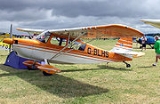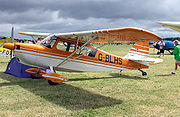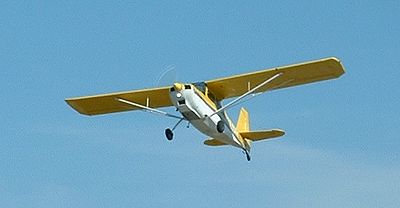
Citabria
Unanswered Questions
Encyclopedia
The Citabria is a light single-engine, two-seat, fixed conventional gear airplane which entered production in the United States in 1964. Designed for flight training
Flight training
Flight training is a course of study used when learning to pilot an aircraft. The overall purpose of primary and intermediate flight training is the acquisition and honing of basic airmanship skills....
, utility
Utility aircraft
A utility aircraft is a general-purpose light plane or helicopter, usually used for transporting people or freight, but also for other duties when a more specialised aircraft is not required or available....
, and personal use, it is capable of sustaining aerobatic stresses from +5g to -2g
G-force
The g-force associated with an object is its acceleration relative to free-fall. This acceleration experienced by an object is due to the vector sum of non-gravitational forces acting on an object free to move. The accelerations that are not produced by gravity are termed proper accelerations, and...
. Its name, "airbatic" spelled backward, reflects this.
Production history
The Citabria was designed and initially produced by Champion Aircraft Corporation, and was a derivative of designs the company had been building since acquiring the 7-series Champ from AeroncaAeronca Aircraft
Aeronca, contracted from Aeronautical Corporation of America, located in Middletown, Ohio, is a US manufacturer of engine components and airframe structures for commercial aviation and the defense industry...
in 1954. The model 7ECA Citabria entered production at Champion in 1964. The 7GCAA and 7GCBC variants, added in 1965, were joined by the 7KCAB in 1968.
In 1970, Champion was acquired by Bellanca Aircraft Corporation
AviaBellanca Aircraft
AviaBellanca Aircraft Corporation is an American aircraft design and manufacturing company. Prior to 1983 it was known as the Bellanca Aircraft Company...
, which continued production of all of the Champion-designed variants. Bellanca introduced two designs with close connections to the Citabria: The 8KCAB Decathlon
8KCAB Decathlon
|-References:Specific references:General references:*Type certificate data sheet no. A21CE. Revision 13. Department of Transportation. Federal Aviation Administration.-External links:* * -See also:...
and the 8GCBC Scout
8GCBC Scout
|- References : *Airworthiness Directive 2000-25-02 R1. Department of Transportation. Federal Aviation Administration.*Service Letter 406. Revision A. American Champion Aircraft....
. Production at Bellanca ended in 1980 and the company's assets were liquidated in 1982.
The Citabria designs passed through the hands of a number of companies through the 1980s, including a Champion Aircraft Company which was no relation to the Champion Aircraft of the 1960s. In that period, only one Citabria model was built—a 7GCBC marketed as "Citabria 150S." American Champion Aircraft Corporation
American Champion
American Champion Aircraft Corporation, located in Rochester, Wisconsin, is a manufacturer of general aviation aircraft. Founded in 1988 on the acquisition of the Champ, Citabria, Scout, and Decathlon, it has been producing replacement parts for these aircraft since that time; it has as well been...
acquired the Citabria, Decathlon, and Scout designs in 1989 and returned the 7ECA, 7GCAA, and 7GCBC models to production over a period of years.
Design
The Citabria traces its lineage back to the Champ. The most noticeable external changes to the design are the Citabria's squared-off rudder surface, wing tips, and rear windows. Like the Champ, the Citabria features tandem seating. The fuselageFuselage
The fuselage is an aircraft's main body section that holds crew and passengers or cargo. In single-engine aircraft it will usually contain an engine, although in some amphibious aircraft the single engine is mounted on a pylon attached to the fuselage which in turn is used as a floating hull...
and tail surfaces are constructed of welded metal tubing. The outer shape of the fuselage is created by a combination of wooden former
Former
thumb|right|150px|Interior of an F-16B with the engine removed showing frames or formers.A former is a structural member of an aircraft fuselage, of which a typical fuselage has a series from the nose to the empennage, typically perpendicular to the longitudinal axis of the aircraft...
s and longeron
Longeron
In aircraft construction, a longeron or stringer or stiffener is a thin strip of wood, metal or carbon fiber, to which the skin of the aircraft is fastened. In the fuselage, longerons are attached to formers and run the longitudinal direction of the aircraft...
s, covered with fabric. The cross-section of the metal fuselage truss is triangular, a design feature which can be traced all the way back to the earliest Aeronca C-2
Aeronca C-2
-See also:-External links:*...
design of the late 1920s.

Rib (aircraft)
In an aircraft, ribs are forming elements of the structure of a wing, especially in traditional construction.By analogy with the anatomical definition of "rib", the ribs attach to the main spar, and by being repeated at frequent intervals, form a skeletal shape for the wing...
. Most Citabrias were built with wooden spars
Spar (aviation)
In a fixed-wing aircraft, the spar is often the main structural member of the wing, running spanwise at right angles to the fuselage. The spar carries flight loads and the weight of the wings whilst on the ground...
. American Champion has been using aluminum spars in the aircraft it has produced and has, as well, made the aluminum-spar wings available for retrofit installation on older aircraft.
The landing gear of the Citabria is in a conventional arrangement
Conventional landing gear
thumb|The [[Piper PA-18|Piper Super Cub]] is a popular taildragger aircraft.thumb|right|A [[Cessna 150]] converted to taildragger configuration by installation of an after-market modification kit....
. The main gear legs of most Citabrias are made of spring steel, though American Champion began to use aluminum gear legs in 2004. Early Citabrias were fitted with steel tube main gear which use an oleo strut for shock absorption. All of the variants are discussed in more detail below.
Operational history

Bush flying
Bush flying is a term for aircraft operations carried out in remote, inhospitable regions of the world. Bush flying involves operations in rough terrain where there are often no prepared landing strips or runways, frequently necessitating that bush planes be equipped with abnormally large tires,...
—thanks to their short take off and landing
STOL
STOL is an acronym for short take-off and landing, a term used to describe aircraft with very short runway requirements.-Definitions:There is no one accepted definition of STOL and many different definitions have been used by different authorities and nations at various times and for a myriad of...
ability, agriculture
Aerial application
Aerial application, commonly called crop dusting, involves spraying crops with fertilizers, pesticides, and fungicides from an agricultural aircraft. The specific spreading of fertilizer is also known as aerial topdressing....
, pipeline patrol, and as glider tow planes. Though variants of the design, and other better-suited designs, have largely taken over the Citabria's utility roles, Citabrias remain popular as trainers, glider tow planes, and for personal use.
7ECA, Citabria Standard, Citabria Aurora
Introduced in 1964, the 7ECA was the first version of the design and utilized the Continental O-200-AContinental O-200
The Continental C90 and O-200 are a family of air-cooled, horizontally opposed, four-cylinder, direct-drive aircraft engines of 201 in³ displacement, producing between 90 and 100 horsepower ....
engine of 100 hp. When introduced, it featured wood-spar wings and oleo-shock main gear. Within the first year of production, Champion began offering the Lycoming O-235-C1
Lycoming O-235
The Lycoming O-235 is a family of four-cylinder, air-cooled, horizontally opposed piston aircraft engines that produce , derived from the earlier O-233 engine....
engine of 115 hp as an alternative to the Continental. In 1967, Champion switched to spring steel
Spring steel
Spring steel is a low alloy, medium carbon steel or high carbon steel with a very high yield strength. This allows objects made of spring steel to return to their original shape despite significant bending or twisting.-Grades:...
main gear legs; by then, the Lycoming engine had become the standard. On acquiring the design, Bellanca gave this model the name Citabria "Standard" and began using the 115 hp Lycoming O-235-K2C engine. When American Champion reintroduced the 7ECA in 1995 as the Citabria "Aurora, " the biggest change was the use of metal-spar wings; the most recent significant design change has been the switch to aluminum main gear legs in 2004.
7GCAA, Citabria 150, Citabria "A" Package, Citabria Adventure
Introduced in 1965, the Champion 7GCAA, like the 7ECA, featured wood-spar wings and oleo-shock main gear. The major difference was in the engine, which in the 7GCAA was a Lycoming O-320-A2BLycoming O-320
The Lycoming O-320 is a large family of 92 different normally aspirated, air-cooled, four-cylinder, direct-drive engines commonly used on light aircraft such as the Cessna 172 and Piper Cherokee. Different variants are rated for 150 or 160 horsepower...
of 150 hp. Champion switched to spring steel main gear legs in 1967. Bellanca continued production of the 7GCAA as the Citabria "A" Package (a designation apparently begun by Champion), but with no significant design changes. American Champion's 7GCAA, reintroduced in 1997 as the Citabria "Adventure," is similar to earlier versions, with the exception of the metal-spar wings and the use of the Lycoming O-320-B2B engine of 160 hp; the most recent significant design change has been the switch to aluminum main gear legs in 2004. An "Ultimate Adventure" version, with a Superior Vantage O-360-A3A2 engine of 180 hp and a composite
Composite material
Composite materials, often shortened to composites or called composition materials, are engineered or naturally occurring materials made from two or more constituent materials with significantly different physical or chemical properties which remain separate and distinct at the macroscopic or...
propeller
Propeller (aircraft)
Aircraft propellers or airscrews convert rotary motion from piston engines or turboprops to provide propulsive force. They may be fixed or variable pitch. Early aircraft propellers were carved by hand from solid or laminated wood with later propellers being constructed from metal...
, is also produced by American Champion.
7GCBC, Citabria 150s, Citabria "C" Package, Citabria Explorer
Champion introduced the 7GCBC in 1965. It was substantially similar to the 7GCAA of the same year, with a Lycoming O-320-A2B engine of 150 hp, wood-spar wings, and spring steel main gear legs. The major differences between these two models are that the 7GCBC has a wingspan of 34.5 feet (10.5 m), 1 foot (0.3048 m) longer than the 7ECA and 7GCAA, and carries wing flapsFlap (aircraft)
Flaps are normally hinged surfaces mounted on the trailing edges of the wings of a fixed-wing aircraft to reduce the speed an aircraft can be safely flown at and to increase the angle of descent for landing without increasing air speed. They shorten takeoff and landing distances as well as...
. Bellanca continued production of the 7GCBC, calling it the Citabria "C" Package (a designation apparently begun by Champion). American Champion's 7GCBC, reintroduced in 1994 as the Citabria "Explorer," is similar to earlier versions, with the exception of the metal-spar wings and the use of the Lycoming O-320-B2B of 160 hp; the most recent significant design change has been the switch to aluminum main gear legs in 2004. A "High Country Explorer" version, with a Superior Vantage O-360-A3A2 engine of 180 hp and larger wheels, is also produced by American Champion.
7KCAB, Citabria "B" Package
Champion introduced the 7KCAB in 1968. It was substantially similar to the 7GCAA of the same year, with wood-spar wings and spring steel main gear legs. The major differences between the7GCAA and 7KCAB were in the fuel system and the engine oil system. The engine was replaced with a Lycoming IO-320-E2A of 150 hp, while a header tank of 1.5 gallons—located beneath the instrument panel—was added to the fuel system. In addition, the carburetorCarburetor
A carburetor , carburettor, or carburetter is a device that blends air and fuel for an internal combustion engine. It is sometimes shortened to carb in North America and the United Kingdom....
was replaced with a fuel injection
Fuel injection
Fuel injection is a system for admitting fuel into an internal combustion engine. It has become the primary fuel delivery system used in automotive petrol engines, having almost completely replaced carburetors in the late 1980s....
system, and a Christen Industries
Christen Industries
Christen Industries was a US aircraft manufacturer founded by Frank Louis Christensen in the late 1970s in Hollister, California to produce an aerobatic biplane of his own design in kit form, the Christen Eagle II. In November 1983, the company acquired Pitts Aerobatics, moved to Afton, Wyoming and...
inverted oil system was fitted to the engine. All of these changes were made in order to allow for extended inverted flight, a mode not possible in the earlier models. Bellanca continued production of the 7KCAB as the Citabria "B" Package (a designation apparently begun by Champion).
Citabria Pro
The Citabria Pro was tested by Champion in 1968, but was never put into production at Champion nor by Bellanca which acquired the company and designs only a short time later. The Citabria Pro was based on the 7KCAB, but with a vertically shortened fuselage, a wing of semi-symmetric airfoilAirfoil
An airfoil or aerofoil is the shape of a wing or blade or sail as seen in cross-section....
mounted in a parasol configuration, and a unique engine, the Lycoming IO-360SPL. While it was flown as a single-seat, there was a second set of controls and room for a second seat. The design changes were intended to produce an aircraft capable of more complex maneuvers and better performance in inverted flight. Sources conflict over whether the Citabria Pro was assigned model number 8KCAB or 9KCAB. Since the 8KCAB designation ultimately belonged to the Decathlon
8KCAB Decathlon
|-References:Specific references:General references:*Type certificate data sheet no. A21CE. Revision 13. Department of Transportation. Federal Aviation Administration.-External links:* * -See also:...
design, which was in development at Champion at the same time, it is unlikely that it was used for the Citabria Pro.
Military operators
The 7GCBC Citabria was used as an observation aircraft by the Turkish ArmyTurkish Army
The Turkish Army or Turkish Land Forces is the main branch of the Turkish Armed Forces responsible for land-based military operations. The modern history of the army began with its formation after the collapse of the Ottoman Empire...
. One of these aircraft is displayed at the Rahmi M Koç Museum
Rahmi M Koç Museum
The Rahmi M. Koç Museum is a private industrial museum in Istanbul, Turkey dedicated to history of transport, industry and communications. Rahmi M. Koç, member of the wealthiest dynasty in Turkey and retired boss of the Koç Group, founded the museum in 1991, which was opened on December 13, 1994...
in Istanbul
Istanbul
Istanbul , historically known as Byzantium and Constantinople , is the largest city of Turkey. Istanbul metropolitan province had 13.26 million people living in it as of December, 2010, which is 18% of Turkey's population and the 3rd largest metropolitan area in Europe after London and...
.
 Turkey
Turkey
- Turkish ArmyTurkish ArmyThe Turkish Army or Turkish Land Forces is the main branch of the Turkish Armed Forces responsible for land-based military operations. The modern history of the army began with its formation after the collapse of the Ottoman Empire...
 Tonga
TongaSpecifications (1975 7GCAA Citabria "A" Package)

External links
- American Champion Aircraft Corporation
- Bellanca-Champion Club
- Aviation displays at the Rahmi M Koç Museum
- Photographs
- New Zealand Citabria page

